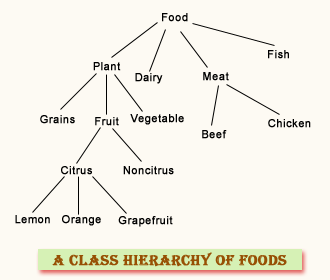|
Class, Object, Method, Polymorphism
Q. Explain the following concepts in context of object-oriented
representations:
| 1. Object (Dec.98, Dec. 00, Dec. 02) |
|
1. Object: An object is an instance of a class. It
can be uniquely identified by its name and it defines a state,
which is represented by the values of its attributes at a
particular time. In other words, an object is a special type
of variable that stores data and manipulates that data by
passing messages to itself. Objects are the basic building
blocks in object-oriented systems. An object consists of a
limited amount of memory, which contains other objects (data
and procedures). They are encapsulated together as a unit
and are accessible to that object only. Examples of objects
are numbers such as 15, 51, 7.51, strings like 'Universal
Teacher Publications', a motor bike, a ship, and so on. Objects
are characterized by attributes and by the way they behave
when messages are sent to them. All objects belong to some
class. They are created by declaring them as instances of
an existing class and instantiating instance variables. The
class to which an object belongs can be determined by sending
it the message "class."
|
| 2. Message (Dec.98, June 99, Dec. 00, June 00, Jan. 01,
June 03) |
|
Message: Actions are performed in an OOS by sending
messages to an object. This corresponds to a function or procedure
call in other languages. The messages are formatted strings
composed of three parts: a receiver object, a message selector,
and a sequence of zero or more arguments. The format of a
message is given as
<object><selector><arg1 arg2 …>
The object identifies the receiver of the message. This field
may contain an object item or another message which evaluates
to an object. The selector is a procedure name. It specifies
what action is required from the object. The arguments are
objects used by the receiver object to complete some desired
task. Messages may also be given in place of an argument since
a message always elicits an object as a response.
There are three types of messages: unary, binary, and keyword
(n-ary). All three types parse from left to right, but parentheses
may be used to determine the order of interpretation. A unary
message requires no arguments. For example, 50 as Character,
5 factorial, 'Universal Teacher Publications' size. Binary
messages take one argument. Arithmetic operations are typical
of binary messages, where the first operand is the receiver,
the selector is the arithmetic operation to be performed,
and the second operand is the argument. Examples of binary
messages are
50 + 10 "an addition message"
10 - 9 "a subtraction message"
22 * 7 "multiplication message"
The most general type of message is the keyword message.
These messages have selectors, which consist of one or more
keyword identifiers, where each is followed by a colon and
an argument. The argument can be an object or any message,
but if it is another keyword message, it must be enclosed
in parentheses For examples,
5 between: 4 and: 10 "a Boolean test"
aecdb' copyFrom: 2 to: 5 "copies position 2 of the string
to position 5"
set1 add: (i + 1) "add new element to set 1"
|
| 3. Method (Dec.98, June 99, June 00, Dec. 00) |
|
Methods: Procedures are called methods. They determine
the behavior of an object when a message is sent to the object.
Methods are the algorithms or sequence of instructions executed
by an object. For example, in order to respond to the message
10 + 7, the object 10 must initiate a method to find the sum
of the integer numbers 10 and 7. On completion of the operation,
the method returns the object 17 to the sending object. Methods
are defined much like procedures in other programming languages
using the constructs and syntax of the given OOS. The constructs
used to build higher level methods are defined in terms of
a number of primitive operations and basic methods provided
as part of the OOS. The primitives of an OOS are coded in
some host language such as an assembler language or C.
|
| 4. Class (Dec.98, Dec. 00, Jan. 01, Dec. 02, June 03) |
|
Class: A class is a general object that defines a
set of individual (instance) objects, which share common characteristics.
For example, the class of balloons contains many individual
balloon objects. The class of natural numbers contains many
instance objects such as 13, 51, 5, … All objects are instances
of some class and classes are subclasses of some higher class,
except for a most general root class. Classes can often be
divided into subclasses or merged into superclasses. The class
of fruit can be divided into citrus and noncitrus, both of
which can be further divided. Fruit is part of the superclass
of plant-grown foods, which in turn is part of the class of
all foods. Classes permit the formation of hierarchies of
objects, which can be depicted as a tree or taxonomic structure
as illustrated in the following figure.

Objects belonging to the same class have the same variables
and the same methods. They also respond to the same set of
messages called the protocol of the class.
|
| 5. Polymorphism (June 00, Dec. 02) |
|
Polymorphism: Polymorphism is the ability of an entity
(for example, variable, function, object, operator) to take
a variety of representations. For example, a message containing
the selector moveForward could invoke the forward movement
of a ship as well as advancing a piece in a game such as checkers.
Both classes use the same message template but respond differently.
The only requirement is that the message protocol for the
two classes be implemented as required for the given class.
|
|
|